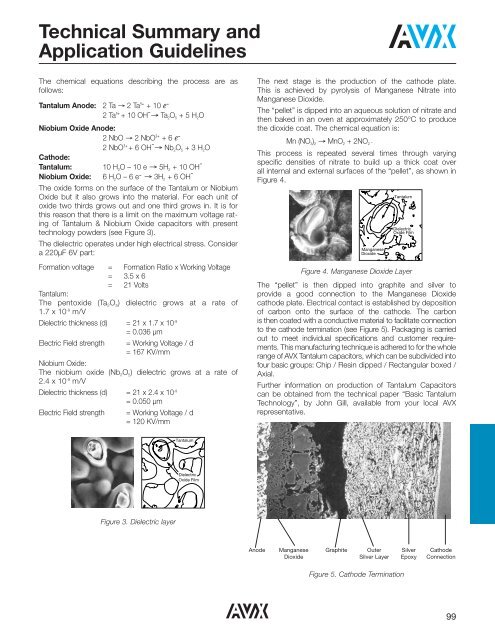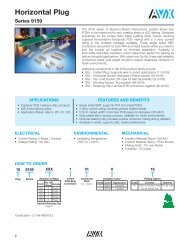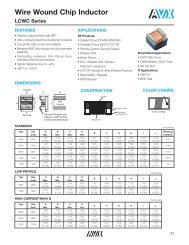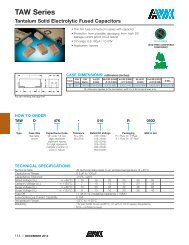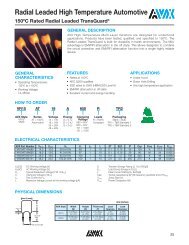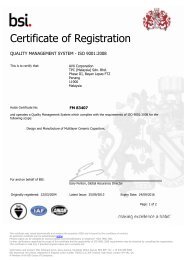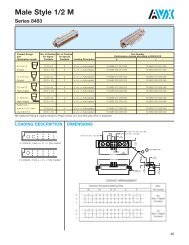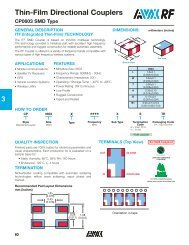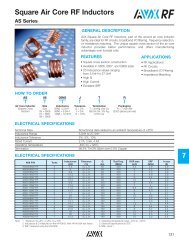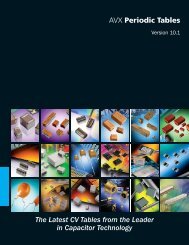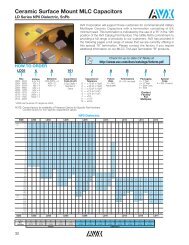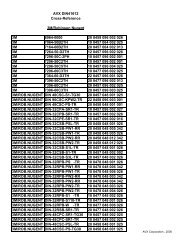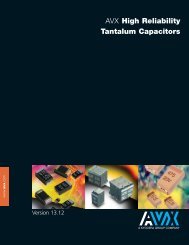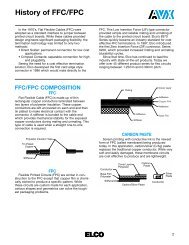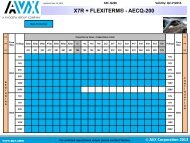TAJ Series Standard Tantalum - AVX
TAJ Series Standard Tantalum - AVX
TAJ Series Standard Tantalum - AVX
Create successful ePaper yourself
Turn your PDF publications into a flip-book with our unique Google optimized e-Paper software.
Technical Summary and<br />
Application Guidelines<br />
The chemical equations describing the process are as<br />
follows:<br />
<strong>Tantalum</strong> Anode: 2 Ta → 2 Ta 5+ + 10 e-<br />
2 Ta 5+ + 10 OH - → Ta 2 O 5 + 5 H 2 O<br />
Niobium Oxide Anode:<br />
2 NbO → 2 NbO 3+ + 6 e-<br />
2 NbO 3+ + 6 OH - → Nb 2 O 5 + 3 H 2 O<br />
Cathode:<br />
<strong>Tantalum</strong>: 10 H 2 O – 10 e → 5H 2 + 10 OH -<br />
Niobium Oxide: 6 H 2 O – 6 e- → 3H 2 + 6 OH -<br />
The oxide forms on the surface of the <strong>Tantalum</strong> or Niobium<br />
Oxide but it also grows into the material. For each unit of<br />
oxide two thirds grows out and one third grows in. It is for<br />
this reason that there is a limit on the maximum voltage rating<br />
of <strong>Tantalum</strong> & Niobium Oxide capacitors with present<br />
technology powders (see Figure 3).<br />
The dielectric operates under high electrical stress. Consider<br />
a 220µF 6V part:<br />
Formation voltage = Formation Ratio x Working Voltage<br />
= 3.5 x 6<br />
= 21 Volts<br />
<strong>Tantalum</strong>:<br />
The pentoxide (Ta 2 O 5 ) dielectric grows at a rate of<br />
1.7 x 10 -9 m/V<br />
Dielectric thickness (d) = 21 x 1.7 x 10 -9<br />
= 0.036 µm<br />
Electric Field strength = Working Voltage / d<br />
= 167 KV/mm<br />
Niobium Oxide:<br />
The niobium oxide (Nb 2 O 5 ) dielectric grows at a rate of<br />
2.4 x 10 -9 m/V<br />
Dielectric thickness (d) = 21 x 2.4 x 10 -9<br />
= 0.050 µm<br />
Electric Field strength = Working Voltage / d<br />
= 120 KV/mm<br />
The next stage is the production of the cathode plate.<br />
This is achieved by pyrolysis of Manganese Nitrate into<br />
Manganese Dioxide.<br />
The “pellet” is dipped into an aqueous solution of nitrate and<br />
then baked in an oven at approximately 250°C to produce<br />
the dioxide coat. The chemical equation is:<br />
Mn (NO 3 ) 2 → MnO 2 + 2NO 2 –<br />
This process is repeated several times through varying<br />
specific densities of nitrate to build up a thick coat over<br />
all internal and external surfaces of the “pellet”, as shown in<br />
Figure 4.<br />
Manganese<br />
Dioxide<br />
<strong>Tantalum</strong><br />
Dielectric<br />
Oxide Film<br />
Figure 4. Manganese Dioxide Layer<br />
The “pellet” is then dipped into graphite and silver to<br />
provide a good connection to the Manganese Dioxide<br />
cathode plate. Electrical contact is established by deposition<br />
of carbon onto the surface of the cathode. The carbon<br />
is then coated with a conductive material to facilitate connection<br />
to the cathode termination (see Figure 5). Packaging is carried<br />
out to meet individual specifications and customer requirements.<br />
This manufacturing technique is adhered to for the whole<br />
range of <strong>AVX</strong> <strong>Tantalum</strong> capacitors, which can be subdivided into<br />
four basic groups: Chip / Resin dipped / Rectangular boxed /<br />
Axial.<br />
Further information on production of <strong>Tantalum</strong> Capacitors<br />
can be obtained from the technical paper “Basic <strong>Tantalum</strong><br />
Technology”, by John Gill, available from your local <strong>AVX</strong><br />
representative.<br />
<strong>Tantalum</strong><br />
Dielectric<br />
Oxide Film<br />
Figure 3. Dielectric layer<br />
Anode Manganese Graphite Outer Silver Cathode<br />
Dioxide Silver Layer Epoxy Connection<br />
Figure 5. Cathode Termination<br />
99


